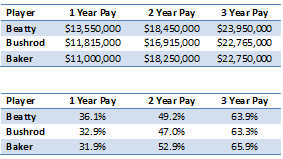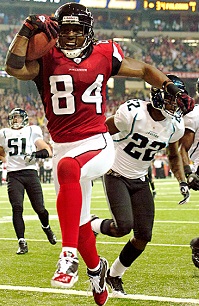[adsenseyu1]
It was reported yesterday that the Raiders and LT Jared Veldheer are working on a contract extension, so I figured we could take a look at what contract possibilities there could be for him. Veldheer is a 26 year old former 3rd round draft choice playing the final year of his contract. He has been sidelined by injury for the first 11 games of the season but prior to that had started 44 games over his three year career and never been injured.
Pass Blocking
I like to break down pass blocking effectiveness using pressures and sacks allowed using a formula I developed where we consider a completed pass as a “success” and an incomplete as a “failure”. Every time a QB drops back to pass he is expected to complete about 63.7% of his dropbacks when he faces no pressure. If he Is pressured that number falls to 43.1%. So what I do with pass blockers is determine the percentage of plays where I can assign then to be the cause of “play failure”.
To illustrate this calculation I’ll use Joe Thomas of the Browns, who has been the best pass blocking tackle in the NFL for the last three years. Using statistics from Pro Football Focus we see that Thomas blocked on 574 plays. With no pressure 574 dropbacks should result in 208.3 failed pass attempts (574 * (1-63.7%)). That is our baseline number for the perfect player.
Thomas has allowed the QB to be pressured 27 times bringing his unpressured dropbacks down to 547, which equals 198.5 failures. Of the 27 pressures one is a sack which equals one failure. Of the 26 other pressures (hits and hurries) we can calculate that the play failed 14.8 times (26 * (1-43.1%)). Add those three numbers together and we calculate that Thomas’ plays resulted in 214.3 failures, so, in essence, his blocking is responsible for 6 non-completions, an increase of 2.88%.
Over the last three years the average left tackle who appeared in at least 50% of his teams passing snaps, allows an increase in failures of 5.01%. The best of the last three seasons was Thomas in 2012 with 2.05% and the worst was D’Anthony Batiste of the Cardinals in 2012 at 11.12%. For players who qualified for at least 2 of the last 3 seasons the average is 4.55%. Thomas again ranks highest at 2.43% for his three years of work while J’Marcus Webb is the worst at 6.66%. Obviously other factors play a role in the effectiveness of a players such as play calling, QB smarts (the Peyton Manning vs Tim Tebow disparity being the greatest), and play grading by PFF, but it’s at least a tool to put some perspective into the position.
Veldheer ranks in the top half of the position in both 2011 and 2012. In 2011 he scored a 4.36%, which ranked 11th for the position. In 2012 he was more effective with a grade of 3.71% which was good for 10th in the NFL. His two year average score of 4.04% ranks 9th among the 27 players who qualified for at least two seasons. That’s a better number than Ryan Clady (4.12%), Joe Staley (4.31%), Jordan Gross (4.84%), Jake Long (5.06%), D’Brickashaw Ferguson (5.1%), Jermon Bushrod (5.16%), and Will Beatty (5.99%).
Run Blocking
I don’t really think teams put significant weight into this aspect of the game when paying a Left Tackle. For one teams simply don’t run that often as the NFL has become a pure passing league. Secondly runs in the direction of the outside part of the line are only around 25% according to data maintained by Football Outsiders. So while the tackle plays a role in all running plays, overpaying for that aspect of the game is a bad business decision. You just want to make sure the player is not going to hurt you in that part of the game.
Veldheer would seem to be a capable player in the run game. in 2012 runs directed at the LT for the Raiders ranked 10th in the NFL. In 2011 they ranked 11th. This year they rank 10th as well without him. While the run personnel is better this season I don’t think anyone will be fooled into overpaying for “rub blocking” nor will they downgrade him for the same.
[adsenseyu4]
Contract Points
I think one of the things that works against Veldheer is the fact that he is a 3rd round draft pick. While late draft picks can make up for their draft positioning, general honors and recognition come far easier for the top picks in a draft, until a player is established, which Veldheer is not having just two full seasons in the NFL. Veldheer also plays in relative obscurity in Oakland because they have been so bad for so many years.
With no Pro Bowls, All Pro seasons, or draft stature pushing a contract I felt that this was probably the best list of comparables I could come up with:

The gold standard here would be Brown, who was a much higher pick and an established four year starter but had yet to earn any Pro Bowl or All Pro nods when he signed his contract. Brown was also a superior player. His pass block numbers the past three years have averaged 3.02% and he was the 4th rated LT in 2011, the year before he signed his mega extension.
Beatty is the name that should interest Veldheer the most. Beatty only started 31 games prior to signing his extension with the Giants this past offseason. New York fell into the one season wonder trap with him. In 2010 he graded at a below average 5.89% but when playing for a new contract saw the number fall down to a terrific 3.38%. The Giants bought in, as teams often do when they believe in a player, and this year he is up to an 8.7% number, second to last in the NFL.
Despite the fact that Veldheer has not played this year he is the player he should be looking to exceed in contract value. Beatty’s two year average of 4.63% leading into his new contract is inferior to Veldheer’s 4.04%. Neither is exactly established at the position. Neither was a high draft pick and neither really rewarded for his play leading into a deal.
Jermon Bushrod could be used to drop the price a bit. Bushrod had more experience and because he was a member of a high powered offense he also received recognition in the form of back to back Pro Bowls. His numbers were only impressive in 2011 (3.83%) and have fallen back to slightly below average after that. His guarantees and cash flows are nowhere near as impressive as Beattys.
The other interesting contract that I want to use to push the price is that of Sam Baker. Baker is another one of those players whose price was pushed by draft status. His 2012 contract year was nothing more than average (4.93% rating) and he was injured in 2011. While his $6.85 million average is not as impressive as the $7.2 million Bushrod received, the cash flows are tremendous. Provided the Falcons pick up a 2014 option his money is also well protected.
The following two tables present the cash flows and percent of five year payouts earned in each year

Potential Salaries
Outside of overpaying for Sebastian Janikowski, which I have to think was a directive that came from ownership, the Raiders front office has not really shown how they will be handling contract negotiations for top tier players. They did make Marcel Reece the highest paid Fullback in the NFL, but that is not a premier position either so I would throw that out. Veldheer is going to be their first high quality signing and may be a precedent point for the organization.
I would think a fair compromise is to match the annual value of the Bushrod contract, but make the cash flows match closer to that of the Baker contract. That would still put Veldheer under Beatty, which may not be fair but I think will be important to Oakland. While I don’t know what they will be planning I don’t sense that they want to be a pricing point for any position.
Due to uncertainty since he was out this year I would also imagine that the Raiders will include playtime bonuses that, in unearned, would bring his contract down to the Baker 5 year number of $6.9 million. If they want to bring him above Beatty than the bonuses I would have would bring him down to Bushrod’s APY. I would also like to get a deal done in the next few weeks if possible. Oakland currently has $2.75 million in cap space and can afford to use up $1.5 million of that on Bushrod this season to lower the dead money at the end of the contract.
The Raiders do have luxury of using more cap space next season than most other teams since they project to have around $70 million in cap space, but if using a somewhat traditional contract structure I’d consider something like this:

In this proposed structure Veldheer receives the first year fully guaranteed and will earn a vesting guarantee in 2015. If he is injured again in 2014 the Raider can move on with just $4.5 million in dead money. They could probably add another vesting guarantee in 2016 as well if they wanted. For cap purposes they could very easily swap the 2014 and 2015 salaries to frontload the contract a bit more. I think as long as 2016 is a reasonable number, since the hope would be that the team actually has players to pay at that point, they won’t be compromised when dealing with other players.
I’ll be interested to see where they go with Veldheer since he is not a marquee name but has played pretty well in his two full seasons. If they use the injury this year to their advantage that’s a great job by the Raiders because there is really no reason for him to not be somewhere in that $7 million to $7.5 million a year range based on how he has played. I’d imagine this will be finalized in the next two weeks.
[adsenseyu2]
[subscribe2]




